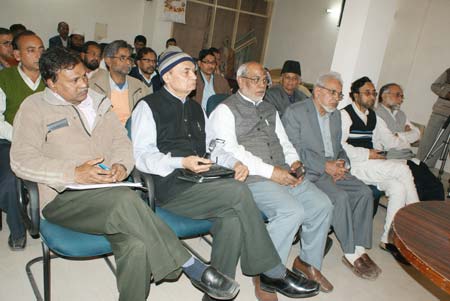|
Dr Shariff was speaking at Institute of Objective Studies on “Relative Development of Gujarat and Socio-Religious Differentials”. On income measures Gujarat comes fourth after Punjab, Haryana and Maharashtra, but in Human Development Index (HDI) it trails behind Kerala, Tamil Nadu, Maharashtra and Karnataka.
“In fact, Orissa has resilience in improved HDI at its own level of development and poverty”, Dr Shariff noted. He said that Gujarat had registered high levels of hunger among its citizens, though higher levels of hunger were not expected of a state with high levels of income.
This suggested deep-rooted poverty and income inequality, Dr Shariff observed. He backed his assertions with figures during his power-point presentation.
He drew the attention of the audience towards what could be termed “the politics of development”. He talked of the hype and hooplah built around foreign direct investment (FDI) in Gujarat.
“Gujarat is a game for NRI and corporate politics … played by the corporate to seek higher tax subsides, cheap licensing, underpriced land and low royalty payments”.
Investments announced in Gujarat were largely promises, as the real amount invested was a fraction of the amount promised due to practical reasons, he said.
His figures, sourced from SIA Newsletter (various years) showed the actual FDI inflows in India from January 2000 to march 2010, as follows: Maharashtra, Rs. 17 lakh crore; N. Delhi, Rs. 10 lakh crore; Tamil Nadu, Rs. 2.4 lakh crore; Karnataka, Rs. 3 lakh crore; Andhra Pradesh, Rs. 2 lakh crore; Gujarat Rs. 2.8 lakh crore. So much for Gujarat being the first destination for FDI in India.

Putting the Muslim situation in this larger framework, Dr Shariff observed, “Empirical evidence suggests that relative to other states and relative to other communities, Muslims in Gujarat are facing high levels of discrimination and deprivation”. He prefaced the remark with the statement that Gujarat had some positive features, namely: 90 percent paved roads to villages; 98 percent electrified villages with 80 percent electrified homes and 18 hours of electricity everyday; 86 percent piped water supply and better phone connections, banks, post offices, bus connection compared to other states. Agricultural extension work, too, is better than in other states. Amid all this, poverty, hunger and lack of sense of security thrive.
Muslims have lower levels of work participation rates suggesting higher unemployment. “WPRs for Hindus in Gujarat are 10 percent higher, suggesting better employment. Muslims in Gujarat have higher unemployment rates compared with Maharashtra and West Bengal”.
He presented some startling facts about the Muslim situation in Gujarat where 60 percent Muslims live in urban areas. Urban poverty among Muslims in “Gujarat is eight times compared to high-caste Hindus and “50 percent more than H-OBCs, even more than SCs/STs. Rural poverty is two times more than HHS”. Banking access to Muslims, who have 12 percent of the accounts, is only 2.6 percent in terms of bank loans/outstanding.
The village and neighbourhood conflict in Gujarat is an astounding 63 percent which is as high as in West Bengal. However, it is lower than UP (82 percent) and Uttrakhand.
In general terms of poverty alleviation, Gujarat has fared very poorly. “MG-NREGA is a national wage employment programme for the poor. Gujarat is the worst performer in MG-NREGA. It has failed to provide employment to the poorest of the poor”, he said.
Muslims in Gujarat have fared rather poorly across the board. Regarding pre-matric scholarships for minorities, a Central government initiative (with effect from April 1, 2008) he said Gujarat happened to be the only large state that had not implemented this programme for 55,000 students, which included 53,000 Muslims along with other minorities.
|